Service Areas
The integration of research and knowledge utilization mechanisms
Software And Data-Intensive Services
The main direction of the Center’s service activities is research and development tailored to local/regional industrial needs:
- developing new procedures, tested prototypes, or marketable products, services, and technological procedures that enhance market efficiency and competitiveness.
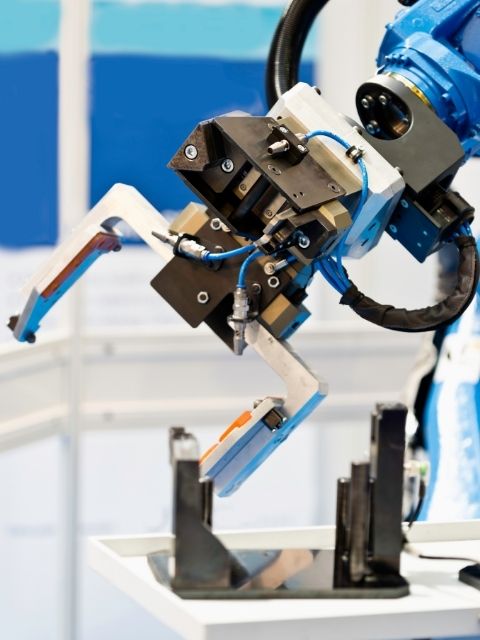
Our Service Areas
Healthcare
Development of signal and image processing, as well as data processing methods, applied in diagnostic imaging devices. Establishing the IT infrastructure for new medical procedures through the integration of large healthcare databases and analysis of healthcare data.
Finance
Digital transformation of financial services, development, and application of data science methods in the field of digital banking services and Fintech.
Industry 4.0
Supporting the implementation of Industry 4.0-based manufacturing technology processes, optimizing manufacturing technology. Launching master's programs in Industry 4.0 and Fintech, dual master's program in computer science, integrating research and development activities into professional training.

Cryptography
Cryptography will undergo significant changes in the next few years in response to the challenges posed by quantum technology. We will examine solutions that are resistant to both traditional and quantum computers, considering the implications of algorithmic changes and how to apply them.
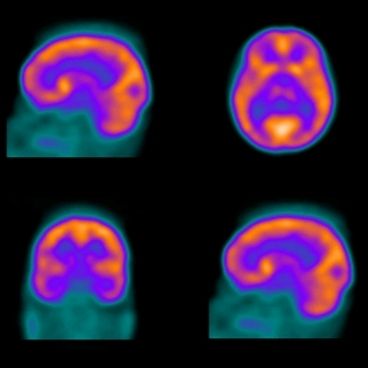
SPECT Imaging
In the evaluation of the heart, we focus on the automatic assessment of two different areas: perfusion and blood pool, known as flow-based procedures, where a high degree of automation is considered innovative. In addition to heart evaluation, brain imaging is another important area where various diseases can be diagnosed and analyzed using the SPECT imaging modality with automated algorithms.

Data-Intensive Analyses
ELTE researchers are establishing a research and development infrastructure and an IT analytics center that builds upon industry-utilized, failsafe data collection technologies. This center is capable of performing data-intensive analyses, specifically for determining parameters measurable only through dynamic methods.
Our Services
![]() Scope
Scope
Traditional test automation does not include test design, requires programming knowledge, and is slow and difficult to maintain. The response to this is model-based testing. However, the model must be “machine-readable”, so it can only be started once the application is ready, requires programming knowledge, and must include every implementation detail. Therefore, it is also slow and sensitive to any implementation changes. Furthermore, the results need to be calculated in advance and inserted into the model.
![]() Solution
Solution
Our team has devised a two-phase approach based on modeling techniques. In the initial phase, the tester creates a high-level textual model, which serves as a descriptive representation including optional system states. This model is used to generate a comprehensive state graph. From the high-level model, abstract tests can be derived, allowing the tester to execute them once the application is prepared. During runtime, the low-level model is constructed, enabling the generation of executable code.
![]() Achievements
Achievements
We have developed an application that simplifies and accelerates the first phase of the test design automation. With this solution, the test code size can be reduced to one-tenth of that required by similar automation approaches. While it typically takes four hours to create a test case using traditional methods, the two-phase modeling approach allows for test case creation in just 20-30 minutes.
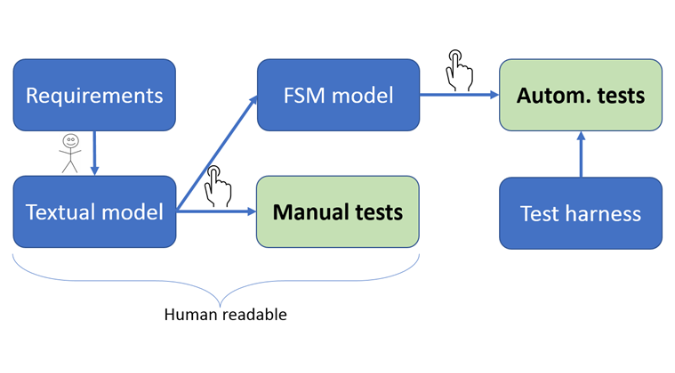
![]() What We Offer
What We Offer
- Training: Our comprehensive training program offers one- and two-day first-hand sessions where participants can learn the most advanced test design methodologies. We have curated engaging tasks available on our website test-design.org to enhance the learning experience. The training also focuses on practical exercises to develop proficiency in modern test automation techniques.
- Consultancy: Most companies lack enough testers but still want to automate their testing processes. We offer services that include test modelling, development of executable tests, and test generation within projects. Additionally, we provide continuous test maintenance to ensure the ongoing effectiveness of the automated tests.
![]() Scope
Scope
Testing is a crucial aspect of software development as the complexity of software continues to rise and release timelines become shorter, increasing the likelihood of faults. Despite the importance of testing, the resources allocated for it are often limited in comparison to the complexity of the software. While automated test execution is common in large software companies, test design is still typically done manually, taking up significant time.
![]() Solution
Solution
One possible solution is the automation of test design. The Model 》Test 》Relax framework generates tests from a given specification model automatically, which checks the System Under Test (SUT) systematically, according to some preset test selection criteria. With automated test design higher product quality can be achieved with the same resources.
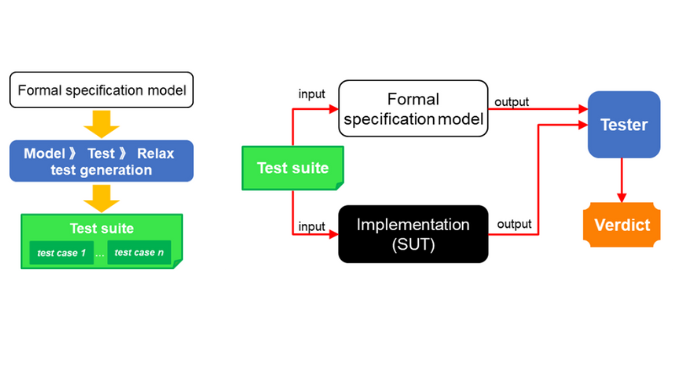
![]() Achievements
Achievements
We have a robust framework equipped with diverse algorithms and features for test generation and model conversion, as well as model and data visualization. We have also implemented newly developed, efficient test generation algorithms.
![]() What We Offer
What We Offer
- Service. We assist in the creation of formal specification models to give a clear, comprehensive understanding of the system for effective communication with stakeholders. Our support also includes selecting optimal test selection criteria that balance resources and product quality. These criteria can be adapted as needed, and various criteria can be set for different testing purposes such as quick checks or pre-release tests. Furthermore, we help in establishing a connection between the specification model and the system under test (SUT) through keywords that serve as a foundation for test execution, resulting in low maintenance costs and independence from implementation.
- Education. Our tool is incorporated into the “Modelling and Testing” course of our Master’s degree program, providing colleagues and students with a comprehensive understanding of model-based testing. The framework’s batch execution capability, adjustable log message levels, data visualization features, and efficient architecture create a stable environment for the development and exploration of new test generation and model conversion algorithms.
Release
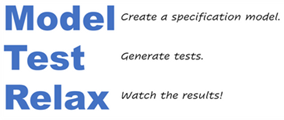
![]() Scope
Scope
The architectural rebuilding and refactoring of large legacy code can be very costly for companies, and often requires custom solutions. Unfortunately, like a clean-up, it is inevitable after a while, it must be done sooner or later, and the longer it is delayed, the more difficult and costly it becomes.
![]() Solution
Solution
Based on the development processes of the companies and their level of maturity, we have developed an agile process in which during the re-architecture procedure, the deviation in quantity and time between the code base belonging to the “old” and the “new” product can be minimized (minimization of investment and inconvenience, maximization of profit).
![]() Achievements
Achievements
The input to the refactoring task is a monolithic user application. The goal is a server-client based modularized architecture, to which modern software development and testing techniques can be applied. During the solution, we can provide a server-side scheduler layer that wraps the monolithic application and enables its fractionation into smaller and smaller pieces. The implementation proceeds from the top down and mostly focuses on two sub-problems. One is the scheduler, which refers to the system organization of server-client and module-module connections, the other is the generalization and highlighting of the control layer of the application.

![]() What We Offer
What We Offer
- Consulting services. Re-architecting is usually a non-trivial task, even defining the exact goals can be complicated. The goals must first be defined, aggregated, and evaluated with the involvement of all actors involved in the development, while adapting to the company’s capabilities and current technological trends during the process. We can aid in the initial phase of the process by detecting the appropriate KPIs and drawing attention to typical pitfalls.
- Prototypes. For the server-client architecture, we have created two general but customizable units. To control the server, a task and resource scheduler based on the principles of the Tomasulo algorithm; and an architecture operating on the cellular principle to represent the business logic of the application, in which the components of the control and the description of the relationship between them are separated.
![]() Scope
Scope
SPECT, also known as single-photon emission computed tomography, is a modality of diagnostics using radio-pharmaceuticals. Its aim is to characterise metabolic processes in tissues that allow functional characterisation of the target organ, such as oxygen uptake capacity, also known as viability.
![]() Solution
Solution
We have algorithms and solutions for the entire protocol of research and development primarily aimed at cardiology. Starting with pharmacological modeling, post-injection fluid flow characterization, reconstruction, and final quantitative evaluations, the solution covers its entire breadth from recording to evaluation. We use modern techniques such as ViT in the case of deep networks for left ventricular segmentation, as well as effective mathematical procedures for reconstruction optimization. It is important to emphasize that the solutions are made distributable in a kind of API-like manner, which enables them to be integrated into the already implemented systems.
![]() Results
Results
The software package can be made available after gradual installation by applying the appropriate control FDA/CE principles. As a result, a tested and quantitative calculation solution is installed, which is unique on the market and can be used to achieve a competitive advantage in addition to reducing recording time.
![]() What We Offer
What We Offer
- Consulting. The implementation and the problems themselves, as well as the data, are not trivial. We can provide the necessary basic knowledge transfer and structure for this. It is important to emphasize that during the consultation, the presence of the entire staff performing the task is necessary, from technicians and doctors to the programmers performing the implementation, so that cohesion can be maintained at the highest possible level.
- Prototypes. Numerous dissertations on already completed technologies and techniques are available on the Internet, and in addition to these, we also provide the complete software package implementing the system, so that the current solutions can be relatively easily integrated and optimized for the current environment.
![]() Scope
Scope
The emergence of welding technologies coincides with the spread of metal structures, marking a very significant stage in the history of technical development. The use of welding techniques for the construction of steel structures is nowadays obvious, even if only from the point of view of economy, but it is inevitable. However, in addition to the payback, the design of the joint in terms of the formation of the material structure often requires careful preparation and attention, since the desired structure is formed by complex thermal processes.
![]() Solution
Solution
In the third quarter of 2021, a six-axis Yaskawa industrial welding robot cell was installed at our institute. The equipment was installed under the “Software and data-intensive services” tender.
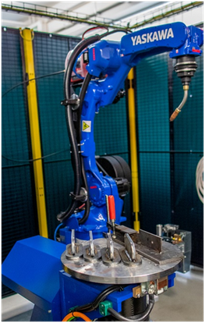
Yaskawa AR1440 robotic arm: with 6 controllable axes,
Load capacity:12 kg, Repeat accuracy: +/-0,06 mm.
Welding power source: Fronius TPS400i, digital inverter, suitable for MIG-MAG process, water-cooled, max. current: 400 A.
Manipulator: Yaskawa MT1-250S2D rotary table, rotatable around 2 axes, load capacity: 250 kg
Work safety: extraction system, work area enclosure, protective equipment.
Offline software: MotoSim VRC, 20 licences
Testing equipment: Equotip 550D hardness tester, X-MET 8000 hand-held material composition tester, Magnetic (MT) test suitcase.
![]() Achievements
Achievements
The aim of the purchase of the robotic cell at our institute was to enable students to study the basics of welding technology, in addition to programming the robot arm’s trajectory. The equipment can also be used to conduct advanced industry 4.0 research at BSc-MSc-PhD level.
![]() What We Offer
What We Offer
- Service. Welding of sheet metal parts with MIG-MAG process. Technologisation of new parts to be manufactured.
- Education. Practical training in mechanical engineering subjects (manufacturing technology, robots).
- Research. industry 4.0, laser technology (welding cell with laser unit), robot motion, image recognition, artificial intelligence, IoT topics basic and doctoral research.
created by: József Szőlősi – assistant research fellow
ELTE-Faculty of Informatics-Savaria Institute of Technology
szjo@inf.elte.hu
Collaboration Opportunities









